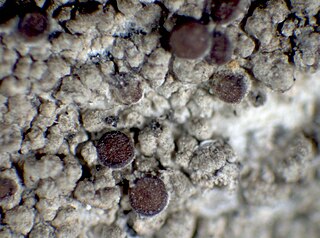
Porina is a genus of crustose lichens in the family Porinaceae. As of August 2024, Species Fungorum accepts 161 species of Porina.

Mazosia is a genus of lichen-forming fungi in the family Roccellaceae.

Megaspora is a genus of lichen-forming fungi in the family Megasporaceae. It contains four species of crustose lichens that typically grow on soil, bryophytes, or plant litter on chalky substrates.
Teuvoa is a genus of lichen-forming fungi in the family Megasporaceae. It was first classified by lichenologists Mohammad Sohrabi and Steven Leavitt in 2013, with Teuvoa uxoris assigned as the type species. This genus was delineated from the larger genus, Aspicilia, following a molecular phylogenetic analysis which revealed that the Aspicilia uxoris species group constituted a distinct lineage in the Megasporaceae. Initially containing three species, two additional species native to China were added in 2018. Teuvoa is characterised by its small ascospores and conidia, and the absence of secondary metabolites.
Inoderma is a genus of lichen-forming fungi in the family Arthoniaceae. It was resurrected for use in 2015 for a small group of species with the following features: elevated, white pruinose pycnidia, immersed to adnate white pruinose apothecia, and a weakly gelatinized hymenium. Inoderma byssaceum was assigned as the type species for the genus.

Reichlingia is a genus of lichen-forming fungi in the family Arthoniaceae. It has seven species. The genus was originally circumscribed by Paul Diederich and Christoph Scheidegger in 1996, with Reichlingia leopoldii as the type, and at that time, only species. The fungus was at first thought to be a lichenicolous (lichen-dwelling) fungus, but is now considered a lichenised hyphomycete.
Calogaya orientalis is a species of corticolous (bark-dwelling) and muscicolous lichen (moss-dwelling), crustose lichen in the family Teloschistaceae. It is found in arid steppe and desert habitats in Northwestern China, Iran, and Turkey. The thallus of this lichen is reduced, similar to species in the genus Athallia.

Coniocarpon is a genus of lichen-forming fungi in the family Arthoniaceae. It has eight species of corticolous (bark-dwelling) lichens. This genus is distinct for its crystalline orange, red, and purple quinoid pigments in the ascomata that turn purple in potassium hydroxide solution, its colourless, transversely septate ascospores with large apical cells, and its rounded to lirellate ascomata.

Flavoplaca oasis is a species of saxicolous (rock-dwelling), crustose lichen in the family Teloschistaceae. It is widely distributed across Europe, and has been reported in Western Asia, China, and North Africa.

Glaucomaria is a genus of lichen-forming fungi in the family Lecanoraceae. It has seven species. The genus was circumscribed by Maurice Choisy in 1929. It contains crustose lichens formerly placed in the Lecanora rupicola species complex as defined by several previous authors.

Glaucomaria carpinea is a species of corticolous (bark-dwelling), crustose lichen in the family Lecanoraceae. It is a widely distributed species.

Myochroidea is a genus of lichen-forming fungi of uncertain familial placement in the order Lecanorales. It has four species of grey or brown-grey crustose lichens.
Carbacanthographis coccospora is a species of saxicolous (rock-dwelling) crustose lichen in the family Graphidaceae. Found in Brazil, it was described as new to science in 2002.

Porpidia macrocarpa is a species of saxicolous (rock-dwelling), crustose lichen in the family Lecideaceae.

Aspiciliella is a genus of lichen-forming fungi in the family Megasporaceae. It has four species. The genus is characterised by its crustose, rimose-areolate thallus that is partially continuous and has a K+ (red) reaction. The epihymenium is typically green to olive-green and turns light green when treated with N. Aspiciliella has eight-spored asci of the Aspicilia-type, containing ellipsoid, colourless, and simple ascospores.

Aspilidea is a fungal genus of uncertain familial placement in the subclass Ostropomycetidae. It contains the single species Aspilidea myrinii, a saxicolous (rock-dwelling) crustose lichen with a circumpolar distribution.

Gloeoheppia is a genus of lichen-forming fungi in the family Gloeoheppiaceae. It comprises five species. The genus is distinguished from similar-looking lichens like Heppia by its internal structure, the nature of its photobiont, and details of its reproductive structures.
Megaloblastenia is a genus of crustose lichen-forming fungi in the family Megalosporaceae, comprising three species. Proposed by Dutch lichenologist Harrie Sipman in 1983, the genus is characterised by its thick, ecorticate thallus ranging from pale whitish-grey to yellowish, and its disc-like fruiting bodies (apothecia) that can be biatorine or lecideine. Megaloblastenia lichens form a symbiotic relationship with Dictyochloropsis algae, produce hyaline, bicellular ascospores with polaribilocular structure, and contain chemical compounds such as zeorin, pannarin, or usnic acid. Found in Australasia and South America, these lichens typically grow as epiphytes on trees in moist forests within temperate to tropical oceanic climates.

Leprantha is a fungal genus in the family Arthoniaceae. It comprises a single species, Leprantha cinereopruinosa, a corticolous (bark-dwelling), crustose lichen.

Arthonia radiata, the asterisk lichen, is a common and widepspread species of corticolous (bark-dwelling), crustose lichen in the family Arthoniaceae.

















